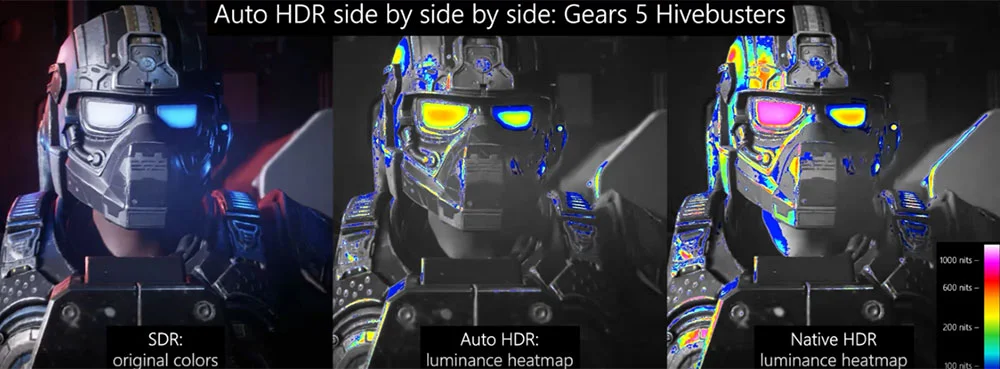What is SDR?
SDR stands for Standard Dynamic Range. It is a term used to describe the standard color and contrast range that most displays and content are designed for. SDR content typically has a lower contrast ratio and a narrower color gamut compared to other formats.
SDR technology has been the industry standard for many years, providing a reliable and consistent viewing experience across a wide range of devices. It is commonly used in television broadcasting, streaming services, and Blu-ray discs. The majority of content available today, including movies, TV shows, and video games, are optimized for SDR.The main advantage of SDR is its compatibility with a wide range of devices. From traditional televisions to smartphones and tablets, SDR content can be easily viewed on various platforms without the need for additional hardware or software. This accessibility has made SDR the go-to format for content creators and consumers alike.
However, as technology continues to advance, there has been a growing demand for more immersive and visually stunning experiences. This has led to the development of High Dynamic Range (HDR) technology, which offers a wider color gamut, higher contrast ratio, and enhanced brightness levels.
HDR content provides a more lifelike and vibrant viewing experience, with brighter highlights, deeper blacks, and a wider range of colors. It allows for more detail to be displayed in both the brightest and darkest parts of the image, resulting in a more realistic and captivating visual experience.
While HDR offers significant improvements over SDR, it is important to note that not all content is available in HDR format. As a result, SDR remains the standard for most content, and many displays and devices still do not support HDR. Therefore, SDR content continues to be widely used and enjoyed by millions of people around the world.

So, SDR is the standard color and contrast range that most displays and content are designed for. It provides a reliable and accessible viewing experience across a wide range of devices. While HDR technology offers a more immersive and visually stunning experience, SDR remains the industry standard for most content. As technology continues to evolve, it will be interesting to see how SDR and HDR coexist and shape the future of visual entertainment.
However, if you are referring to the role of a Sales Development Representative (SDR), then there are several reasons why someone might want to pursue this career path. Being an SDR can offer a unique and fulfilling experience for individuals who enjoy building relationships, have excellent communication skills, and thrive in a fast-paced and competitive environment.
One of the main reasons why someone might want to be an SDR is the opportunity to develop valuable skills that can be transferable to various industries and roles. As an SDR, you will learn how to effectively communicate with potential customers, qualify leads, and navigate the sales process. These skills are not only essential for a successful career in sales but can also be beneficial in other areas such as marketing, customer success, or even entrepreneurship.
Another reason why individuals are drawn to the role of an SDR is the potential for career growth and advancement. Many companies have well-defined career paths for SDRs, allowing them to progress into more senior sales roles or transition into other departments within the organization. This can provide a sense of stability and long-term career prospects for individuals who are looking to grow and develop professionally.
Additionally, being an SDR can offer a unique opportunity to work closely with a diverse range of clients and industries. This exposure allows individuals to gain valuable insights into different markets, understand customer needs and pain points, and develop a deep understanding of the products or services they are selling. This knowledge can be invaluable in building a successful career in sales or even pursuing entrepreneurial ventures in the future.
Furthermore, the role of an SDR often comes with attractive compensation packages, including base salary, commission, and bonuses. While the specific compensation structure may vary from company to company, the potential for earning a lucrative income is certainly a motivating factor for many individuals considering a career as an SDR.
Finally, the satisfaction that comes from successfully connecting with potential customers, overcoming objections, and ultimately closing deals can be incredibly rewarding. The role of an SDR requires persistence, resilience, and the ability to handle rejection. However, the thrill of securing a new client or contributing to the growth of a company can make all the hard work and effort worthwhile.
SDR vs. HDR
When it comes to gaming, HDR (High Dynamic Range) generally offers a more immersive and visually striking experience compared to SDR. HDR allows for a wider range of colors, higher contrast ratios, and more detailed shadows and highlights. This can enhance the overall realism and depth in gaming graphics.
However, it’s important to note that the benefits of HDR can vary depending on the specific game, the display capabilities, and the content being played. Some games may not fully utilize HDR, or the display may not have sufficient HDR capabilities to showcase the full potential. In such cases, SDR can still provide an enjoyable gaming experience.
One of the key advantages of HDR in gaming is its ability to reproduce a wider color gamut. This means that HDR displays can accurately represent a larger range of colors, resulting in more vibrant and lifelike visuals. With SDR, the color range is more limited, which can lead to less realistic and duller graphics.
In addition to color, HDR also offers higher contrast ratios, which can greatly enhance the overall image quality. This means that HDR displays can simultaneously display bright highlights and deep blacks, resulting in more detail and depth in the visuals. On the other hand, SDR displays may struggle to accurately reproduce both bright and dark areas, leading to a loss of detail in the image.
Another area where HDR excels in gaming is in the reproduction of shadows. HDR displays can render shadows with more precision and detail, making them appear more realistic and immersive. This can greatly enhance the atmosphere and overall visual experience in games that heavily rely on shadows and lighting effects.
However, it’s worth mentioning that not all games are optimized for HDR. While more and more games are starting to support HDR, there are still many titles that are designed primarily for SDR displays. In these cases, playing the game in HDR mode may not provide significant visual improvements, as the game was not specifically developed to take advantage of HDR features.
Furthermore, the effectiveness of HDR in gaming also depends on the display’s capabilities. Not all HDR displays are created equal, and some may have limited brightness levels or color accuracy, which can affect the overall HDR experience. It’s important to choose a display that offers high-quality HDR performance to fully enjoy the benefits of this technology.
In conclusion, while HDR generally offers a more immersive and visually striking experience in gaming, its effectiveness can vary depending on the specific game and the display’s capabilities. SDR can still provide an enjoyable gaming experience, especially if the game is not optimized for HDR or the display lacks sufficient HDR capabilities. Ultimately, the choice between SDR and HDR for gaming depends on personal preferences and the specific gaming setup.
How to make SDR look like HDR?

While it is not possible to completely transform SDR content into true HDR, there are some techniques and settings that can help enhance the SDR viewing experience to make it resemble HDR to some extent:
- Dynamic Contrast: Adjust the contrast settings on your display to increase the difference between bright and dark areas. This can help improve the perception of depth and highlight details in SDR content.
- Color Saturation: Increase the color saturation settings on your display to make the colors appear more vibrant and vivid. This can compensate for the narrower color gamut of SDR.
- Ambient Lighting: Consider adding ambient lighting behind your display or in your gaming environment. This can help create a more immersive experience and enhance the perceived contrast.
- Post-processing Effects: Some displays or graphics cards offer built-in post-processing effects that can simulate HDR-like visuals. Explore the settings and options available to see if any of these features can enhance your SDR content.
- Upconversion Algorithms: Another technique to make SDR content look like HDR is through the use of upconversion algorithms. These algorithms analyze the SDR content and apply specific adjustments to simulate the dynamic range and color depth of HDR. While the results may not be as accurate as true HDR, they can still provide a more visually appealing experience.
- Gamma Correction: Adjusting the gamma settings on your display can also help enhance the SDR content to resemble HDR. Gamma correction is a technique that alters the brightness levels of an image to optimize its visual appearance. By fine-tuning the gamma settings, you can achieve a more balanced image with improved contrast and detail.
While these techniques can improve the SDR viewing experience, it’s important to note that they cannot fully replicate the true HDR experience. To fully enjoy the benefits of HDR, it is recommended to invest in a display that supports HDR and consume HDR content specifically designed for it. However, if you are unable to upgrade your display or access HDR content, these techniques can provide a temporary solution to enhance your SDR content and make it resemble HDR to some extent.
Can you convert SDR to HDR?
Converting SDR (Standard Dynamic Range) content to true HDR (High Dynamic Range) is a complex process that requires specialized hardware and software. It is not something that can be easily done by the end user.
There are some software solutions available that claim to convert SDR to HDR, but their effectiveness and the quality of the results can vary. These solutions typically rely on algorithms and image processing techniques to enhance the dynamic range and color gamut of SDR content, but they cannot fully replicate the true HDR experience.
If you are looking to experience true HDR, it is recommended to consume content that is specifically designed and mastered in HDR, and to use a display that supports HDR capabilities.
When it comes to converting SDR to HDR, there are a few factors to consider. One of the main challenges is the difference in the dynamic range between SDR and HDR content. SDR content typically has a lower dynamic range, which means it has a narrower range of brightness levels. HDR content, on the other hand, has a much wider dynamic range, allowing for more detail in both the shadows and highlights.
In order to convert SDR to HDR, the software or hardware needs to analyze the SDR content and adjust the brightness and contrast levels to match the wider dynamic range of HDR. This can be a complex process, as it requires accurately mapping the brightness levels of the SDR content to the HDR range without losing detail or introducing artifacts.
Another challenge in converting SDR to HDR is the difference in the color gamut. HDR content typically uses a wider color gamut, which means it can display a larger range of colors. SDR content, on the other hand, uses a more limited color gamut. When converting SDR to HDR, the software or hardware needs to adjust the color gamut of the SDR content to match the wider color gamut of HDR. This can be a challenging task, as it requires accurately mapping the colors of the SDR content to the HDR color space.
Overall, while there are software solutions available that claim to convert SDR to HDR, it is important to manage expectations. These solutions can enhance the dynamic range and color gamut of SDR content, but they cannot fully replicate the true HDR experience that is achieved with content specifically designed and mastered in HDR. If you are looking to experience the full benefits of HDR, it is recommended to consume content that is natively in HDR and to use a display that supports HDR capabilities.



